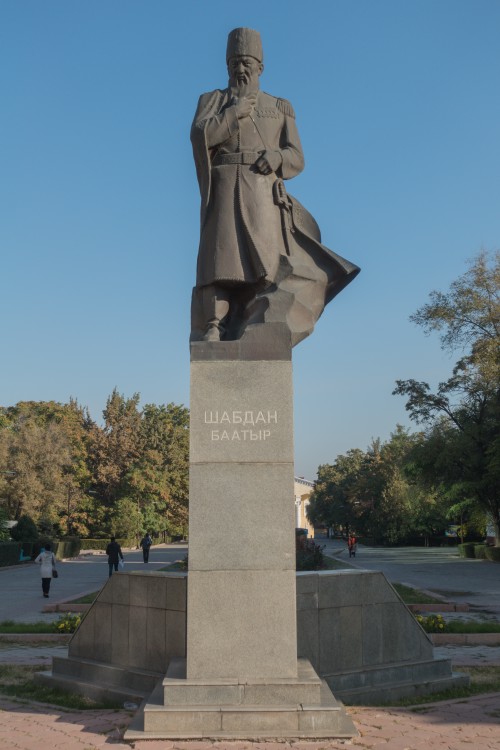
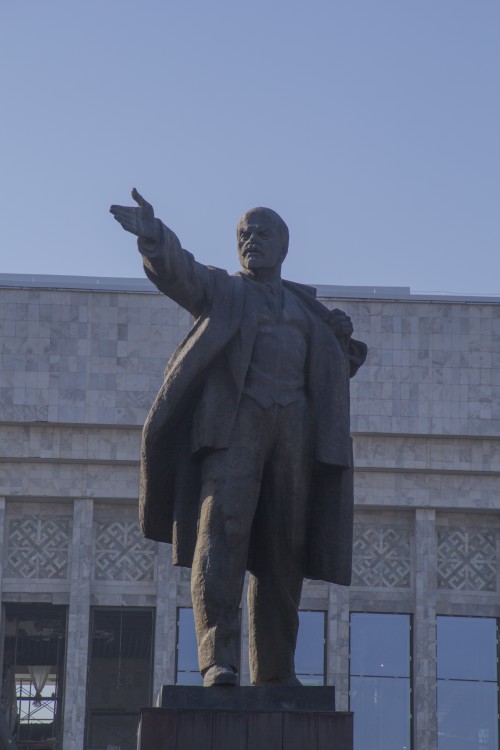
We got up between 7 and 8 today. The shower doors were hard to open and close, to the point Crystal was worried about breaking them when she was moving them. This hotel had the same sort of corner-oriented, quarter-circle shower that had been almost everywhere on this trip. Before eating breakfast, we went down to get money from the ATM, and as usual Justin failed and Crystal succeeded. Crystal always does better at the ATM in foreign countries, Justin always does better at immigration lines. Once again, breakfast was blah. There weren't that many people, but it wasn't completely barren either. We checked out - although we were due to come back in a couple days - and then took out all our bags to meet Jalil and Rames. Relative to us, Jalil has got to be the youngest guide we've had so far, although invariably they will get younger every year.
Our first stop today was at the National University, in front of a statue for Yusuf Balasugun. He was a great thinker of the Middle Ages, and a poet and philosopher among other things. He is famous in Kyrgyzstan for authoring a book called " Beneficient Knowledge." From there we walked south towards Chuy Avenue and the City Hall (Mayor's office). This walkway is informally referred to as the "pathway of youth," and used to be filled with a median of flowers, but now there are some fountains in addition to the flowers. The whole walk, in the distance to the South, there were beautiful snow-capped mountains. At the south end of the pathway of youth was a statue of Shabdan Baatyr. He was one of the tribal rulers in Kyrgyzstan, and he led the charge for the various nomadic tribes to become part of the Russian Empire in the 1800s.
 |
 |
Kyrgyzstan (and Kazakhstan), unlike Uzbekistan and Turkmenistan, actually wanted to be a part of the Russian Empire. "Wanted" may be too strong a phrase, as they were surrounded by much stronger and more populous areas such as Russia, China, India, Iran, etc. In the late 1800s they saw the writing on the wall, and more-or-less chose the Russians as the best party to align with. Shabdan Baatyr led this movement. Jalil said something about this story loosely being the basis for Game of Thrones (or something like that), but we can't really recall, and since we don't watch Game of Thrones we don't really have any basis to agree or disagree.
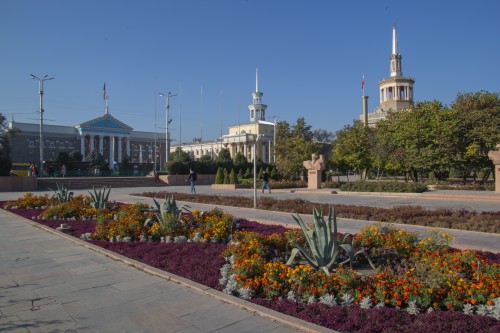 |
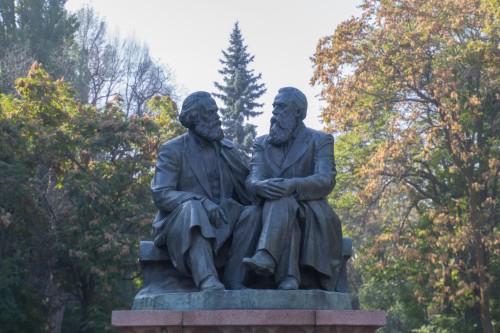 |
Nearby was a statue of Manas, on a horse, with lots of real birds on top of the statue. Manas is something we can't really explain, or frankly explain at all. Best as we can tell from our brief time in Kyrgyzstan, Manas is a story or collection of poems. They subject matter is the history of Central Asia, and more specifically the Kyrgyz areas, specifically the interaction between the Turkic people and the Mongol people. The poem/story has about 500,000 lines, and is arguably the longest epic poem in the world. [Perhaps Turkmenistan has claimed something longer.] It is unclear (or at least unclear to us) if Manas was also a person, and if so, if he was a real person or something like Robin Hood. There's a reason this is so unclear, as the story has been passed on for centuries by recitation alone, and not formally recorded. Accordingly, this could have been like a very bad game of telephone. Thinking about it, this is the sort of thing that Imam Bukhari tried to square away and formalize regarding the various Hadiths, so that people could tell fact from fiction.
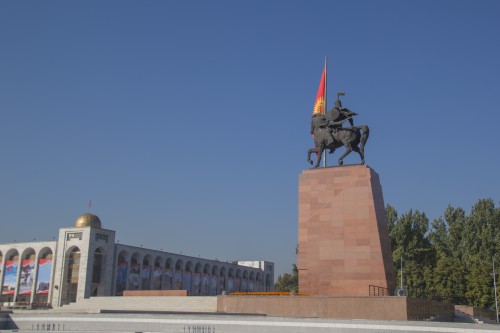 |
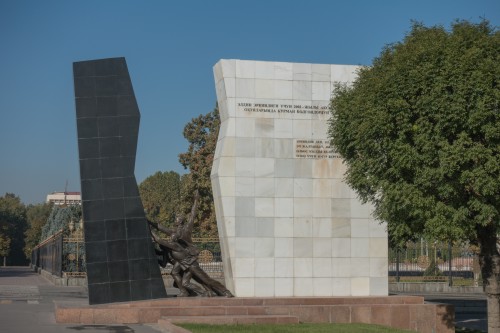 |
After looking at the Manas statue and all the birds, we got in back in the car and drove to the history museum. There we saw a statue of Lenin. Unlike Turkmenistan and Uzbekistan, Kyrgyzstan did not destroy all signs of the former Soviet times. Part of this could be that Kyrgyzstan "chose" to become part of Russia in the pre-Soviet area, whereas Turkmenistan and Uzbekistan did not. Jalil commented a common refrain heard throughout the southern part of the U.S., that you "can't erase history." But, to their credit, the Kyrgyz have re-organized and prioritized history. The Lenin statue used to be at a prime location in Oak Park, but in 2003 was moved to this location, literally (and figuratively) at the back of history. Adding insult to injury, in the statue Lenin was pointing in one direction, and after being moved in 2003, the direction he was pointing was to the American University, which was across the street. [The University has since been renamed.] Nearby was a statue of Karl Marx and Friedrich Engels.
At the front of history, or specifically the History Museum, was another Manas statue. This one was put up in 2011, coinciding with the 20th anniversary of Kyrgyzstan as an independent nation. The next statue we saw was as a memorial for people killed in recent revolution events. In 2002, and also in 2010, people protested the government, and in each case people opened fire on the demonstrators. Six people died in 2002, and 86 people died in 2010. The statue depicts people pushing a black stone (depicting evil) away from a white stone (depicting good). Jalil indicated that far more people would have died in 2010, except for the fact that the military laid down their weapons, and only some snipers actually fired on the crowds. He also mentioned that after several revolutions since 1990, now people want stability. A major Presidential election was actually slated for the day we were scheduled to leave. Jalil mentioned that the President in Kyrgyzstan is in charge of foreign activity and military, and that the Prime Minister is in charge of domestic activity.
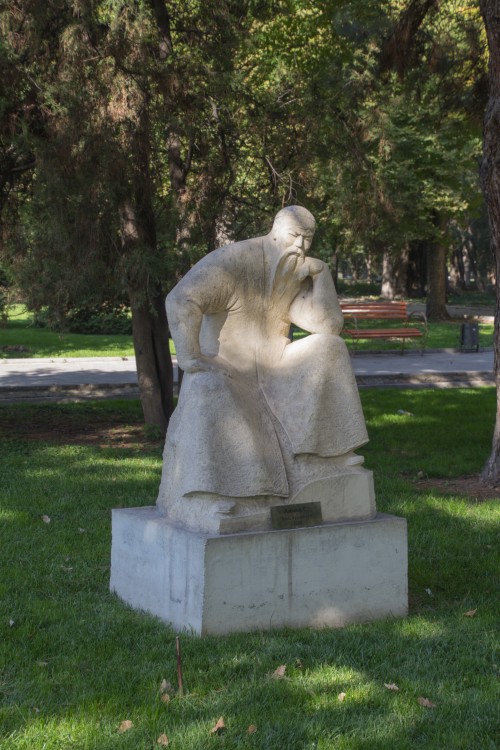 |
Not only is there a statue of Shabdan Baatyr (who was seeking to merge with Russia), there is a statue of Kurmanjan Datka (who was fighting against that). Jalil mentioned it is unusual to have statues for leaders on both sides of a dispute. Datka opposed annexation, but when it was clear that resistance was futile, she and the remaining Kyrgyz resistance surrendered. Thereafter, her sons were arrested, and one was sentenced to death. Rather than try to help him escape, she actually attended his execution. She knew if she tried to fight the result, it would have caused issues for all the people of Kyrgyzstan when the Russians retaliated. There were quite a few more statues in the park, as there was a large public art section. In the same area was a statue of Cholponbek Bazarbaev, a famous ballet dancer that was known even in Western Europe.
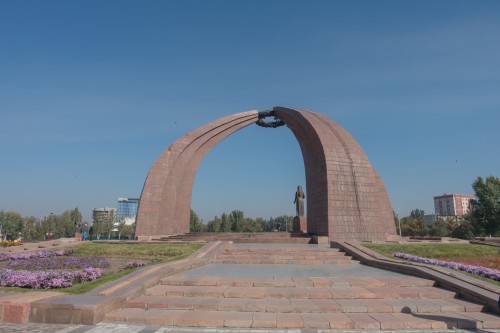 |
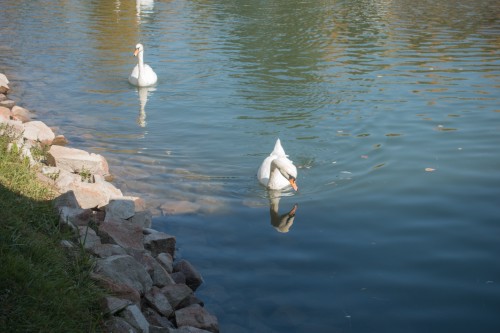 |
We were walking through a downtown-like area, and we saw a parking lot that was full of tarps, like at a farmer's market. When we got closer, there were bees everywhere, as this was a collection of vendors selling honey. We tried a couple of different kinds, and they were excellent. We normally don't like honey, but we liked these. Our next stop was a World War II memorial, depicting a yurt with only three of four sides. The missing side signified that one in four people who left for the war never came back. There was supposedly an "eternal" flame as well, but it was out.
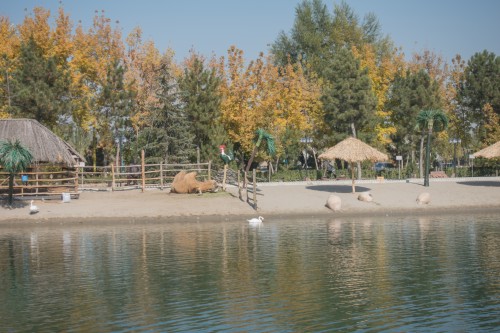 |
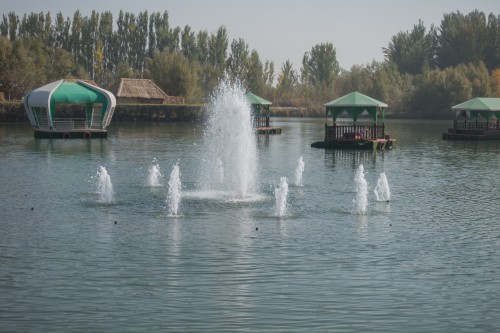 |
From Bishkek we headed northeast, towards Burana. In short order we were on a highway that effectively was just inside the Kyrgyzstan border, with a river and then Kazakhstan on the other side of the border. Jalil mentioned that the river would change course, and change the border in the process. So Kyrgyzstan built the road, and the grading around it, to prevent any further "creep" of the river to the south. But there was one small section where we drove through Kazakhstan for about 30 seconds, with fencing all around, before crossing back over the river and back in Kyrgyzstan. About a minute or two later we stopped at this resort, where we were going to have lunch. It was kind of a weird, eclectic type of place. There was a large pond full of swans. In addition to that, there were fake palm trees, a camel, classic cars, and more. The restaurant was Hawaii-themed, and was built on pilings that extended the restaurant out over the pond, where there were people boating, fountains spraying, and swans swimming around. The menu looked really good, and it was hard to choose what to eat. Justin got some spicy diced chicken (not the greatest, particularly when everything looked so good), Crystal got lamb and potatoes (good), but Rames made the best choice, getting some shashlick that looked amazing.
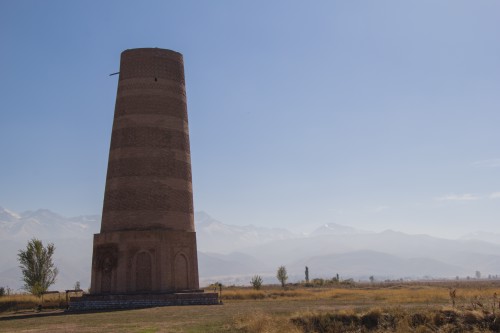 |
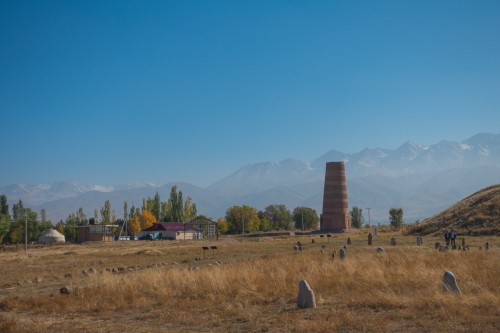 |
After lunch, our next stop was the Burana Tower, another stop on silk road. It was built by the Karakhanids at the end of the 9th century, and was part of the city of Balasagun (which is no more). This was also repaired by Soviets, but was much more rustic than the stuff we saw in Uzbekistan. It was about on par with Kunya Urgench in northern Turkmenistan, but here there was just the single tower. Jalil showed us around a small museum, with coins and petroglyphs. And bees, there were lots of bees for some reason. We saw some mounds, which were the only indication of former city walls. We could make them out only because it was otherwise very flat here - otherwise the mounds would have looked like normal undulations. The tower itself was built only about 60% of the way back. Crystal sat out the walk to top, which was cramped like the tower in Khiva. The view from the top was nice (there was some sort of hawk or eagle flying around), but it was too bad it was not more clear, as there were numerous mountains nearby. The lack of clarity was from lots of dust and smoke from farming activities. We had not been expecting so much smoke, and it was irritating our eyes a bit.
 |
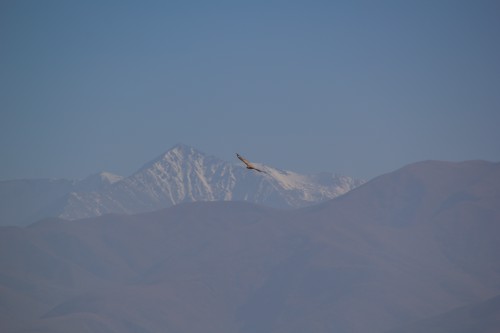 |
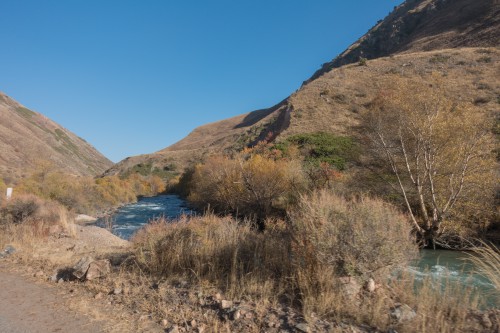 |
Back in the car, we continued to head east, and the mountains crept in from both sides (north and south) as we continued. Eventually the valley we had been in disappeared, and we were in the mountains, headed out to Chon-Kemin. There was a river cutting through the mountains, and after going through a pass, we came out in a different valley, the Kalmak-Ashuu Valley. There were small farms, pastures, and meadows, with little villages here and there. All of a sudden we just stopped at a small B&B in the middle of nowhere, the Ashu Guesthouse. Interestingly, after we unpacked, we realized there was lightning fast wi-fi, so go figure. We caught up on pictures and the trip log, and checked news. Ironically, in looking at stuff from our contractor about our remodel, we saw a video of a Blum cabinet installation, as just this morning we saw a person in the park in Bishkek looking at a Blum catalog - small world.
 |
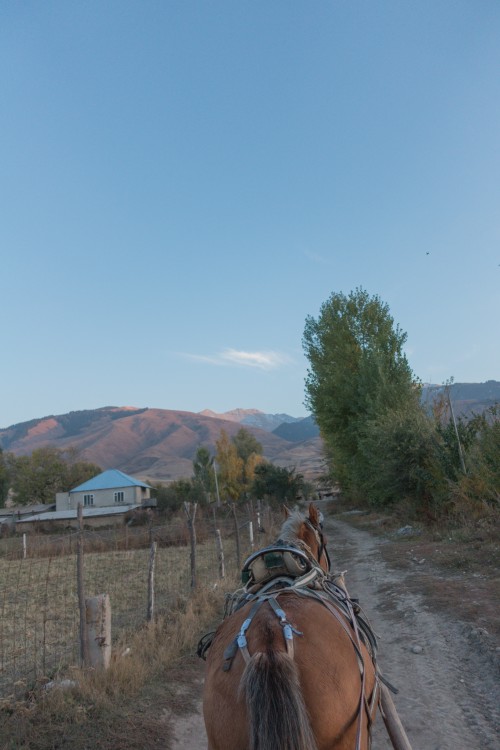 |
Shortly before sun down, we left the B&B on a horse cart to a giant hoe in the middle of the valley. Jalil mentioned that the person who started the guest house put the piece of art together a few years back. We weren't sure of the point, but maybe it was there to reinforce a feeling of being outdoorsy. The sculpture was dedicated to the people who worked the land over the years. We went back to the guest house for dinner. At dinner, it was just the four of us. Tourist season goes from May to September, so we were a little late to the party, and accordingly we had the place to ourselves. Manti (large meat dumplings) was the main course. We also had Sherpa soup (broth, meat, potatoes, carrots), which is also a staple. There was also a tomato/cucumber/onion salad. Crystal ate the big chunks, Justin ate the small chunks. There was also bread (not the same great bread we'd had throughout Turkmenistan and Uzbekistan), with local honey and raspberry jam. Everything was excellent. After a long day of travel, we went to sleep early.
| Previous | Index | Next |